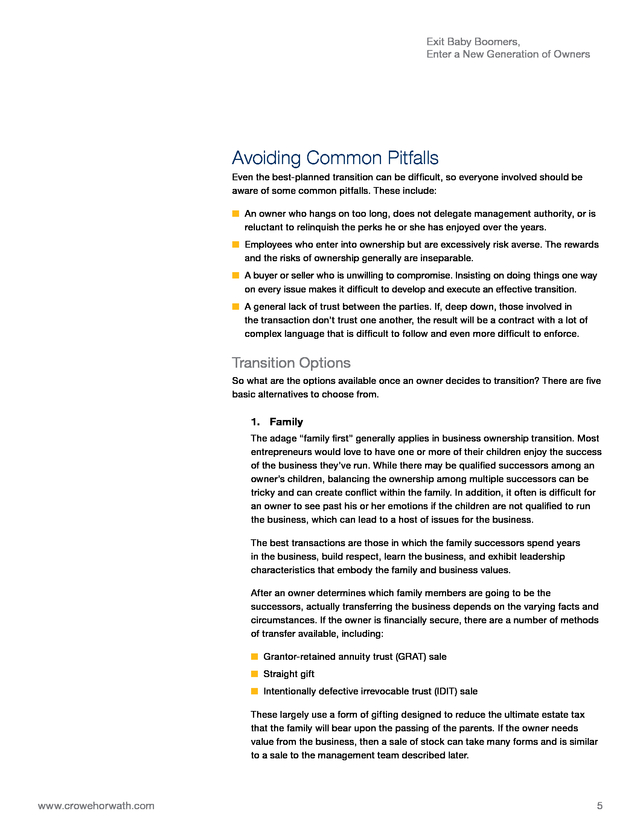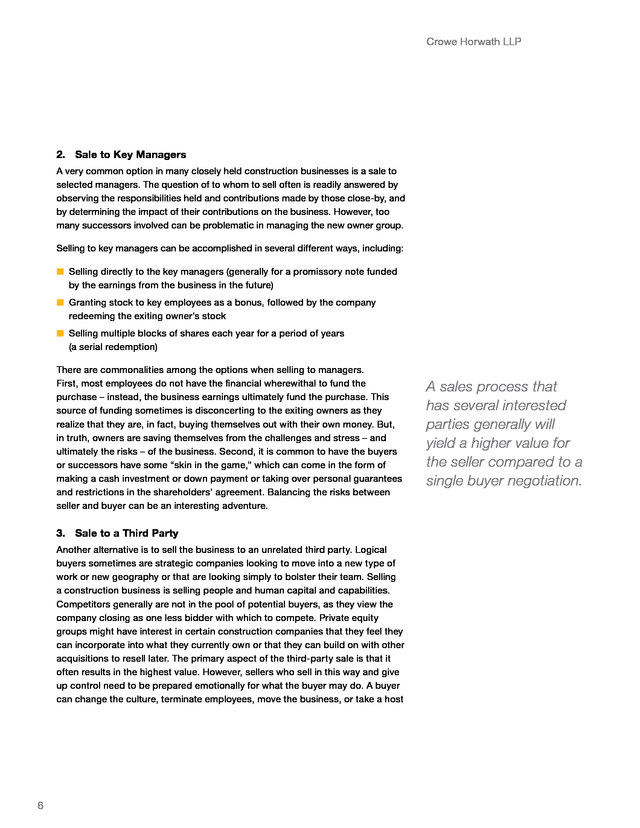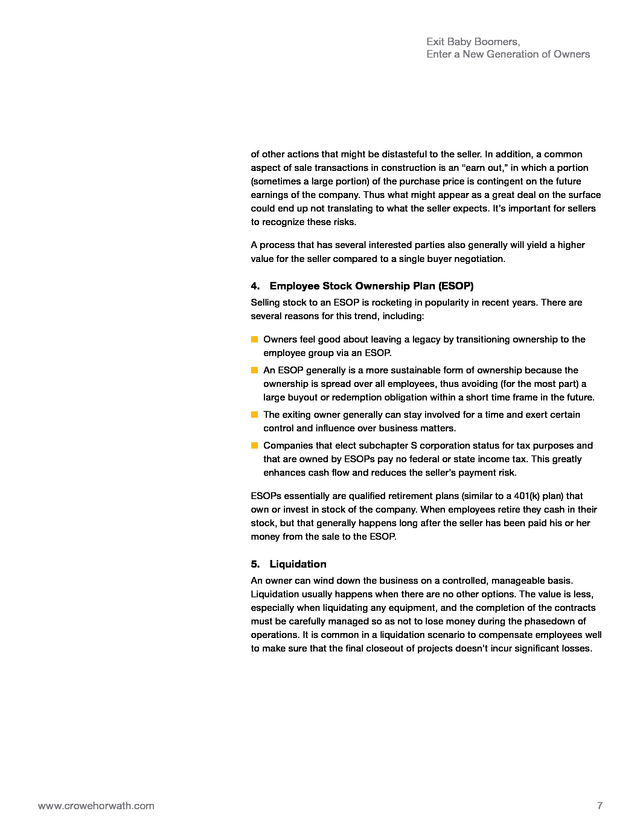
Severity: Notice
Message: Undefined variable: content_category
Filename: user/transcript.php
Line Number: 106
Severity: Warning
Message: Invalid argument supplied for foreach()
Filename: user/transcript.php
Line Number: 106




1) February 2016 Exit Baby Boomers, Enter a New Generation of Owners By Timothy J. Iszler, CPA, and Larry A. Mackowiak, CPA Audit | Tax | Advisory | Risk | Performance
2) Crowe Horwath LLP Over the next 10 years, tremendous value will transition to new owners as baby boomers who own businesses with significant value retire and exit the marketplace. Some baby boomers will exit gracefully, with well-planned processes to transition to qualified successors. Others will struggle with how to tackle this important process (including who to involve) and some will be crippled by indecision, not even able to begin the process. Succession planning – an important part of any organization’s long-term strategy – can pose special challenges for construction companies, but owners and buyers can take steps to help make sense of the various alternatives available to them and to make the transition a smooth one. Numerous issues are involved in the construction industry – where risks are high, the entrepreneurial spirit thrives, and an owner’s financial and emotional attachment to the company often is strong. Because of these ties, owners often put off succession planning, concentrating instead on today’s pressing issues. However, more forward-looking owners will plan proactively for the next generation of ownership to the benefit of everyone involved. Planning the Transition Although some construction companies are sold to private equity firms or strategic buyers, the more typical transition involves transferring ownership to an internal management team or members of the owner’s family. The first step in planning for such a transaction is to address some basic questions. For the exiting owner, important preliminary questions include: What type of retirement plans does he or she have in mind? Will retirement include extensive travel or expensive hobbies? What cash stream will be needed to support the owner’s new lifestyle? Has the owner built wealth outside the business to help finance retirement? For the buyers, the initial significant questions revolve around valuation: What is the business worth? What kind of income does it generate? Will the transaction be affordable to the company? Underlying both sets of questions is one fundamental fact: For any succession plan to work well, the company must be generating stable profits from operations. 2
3) Exit Baby Boomers, Enter a New Generation of Owners Financing the Sale When a group of employees plans to buy out an owner, the employees involved typically will not have enough personal wealth for an outright purchase. That leaves two sources to fund the sale – bank debt or owner financing. Bank debt often is problematic because of surety constraints. Bonding companies are keenly interested in a company’s financial stability, and adding sizable bank debt to the balance sheet will create a high debt-to-equity ratio, making it difficult to obtain bonding for larger jobs. Debt owed to a previous owner, on the other hand, generally is held off the balance sheet, since the debt is owed by the individual owners to the previous owner. Thus, the company’s debt-to-equity ratio remains unaffected. Owner financing raises other issues, though, such as how the transaction is structured, how long the payout period will be, and what level of control the exiting owner will retain. Structuring the Payout Typical payout periods for owner-financed sales range between seven and 12 years, but every transaction is different. The so-called “right” way to structure a payout is determined by an affordability analysis, which considers the company’s estimated profitability, its expected tax burden, and other upcoming obligations such as the need to buy capital equipment and generate income for the new owners. A long-term transition during the sale is the price of freedom from the day-to-day responsibility of running the business. The payout must be quick enough to protect the departing owner, yet not so aggressive that it cripples the company or makes it unattractive to buyers. In almost every instance, the exiting owner will want to maintain some level of control during the payout period. Maintaining this level of involvement usually is accomplished by splitting the stock into voting and nonvoting shares. The retiring owner can then turn over majority ownership, but still retain all or most of the voting stock – and maintain control of the company – until the payout is complete, which helps mitigate the risk of nonpayment. A long-term transition often prompts exiting owners to complain that they’re ultimately “paying themselves with their own money.” Although this may be true to a degree, it’s the price of freedom from the day-to-day responsibility of running the business. The alternatives are to simply liquidate the company (which would almost certainly provide a much lower return) or sell to an outside buyer, which would still involve retaining certain important members of the management team if the business is to be sold at its ultimate value. www.crowehorwath.com 3
4) Crowe Horwath LLP Protecting Everyone’s Interests A carefully prepared purchase agreement is essential, and all parties to the transaction should consult closely with their legal and tax advisors. For the exiting owner, a significant concern is enforcement and the remedies that are available if the note isn’t paid. Other issues include the departing owner’s management role during the transition as well as continuing salary and benefits. For their part, the new owners will want some flexibility in the payment schedule, so that a few bad months during an economic slowdown won’t make them unable to ultimately acquire full ownership. To protect the seller, the purchased stock or other collateral often is held by an escrow agent, with negotiated release points as the note is paid down. As with any significant financial transaction, the tax consequences also must be considered. The way the sale is executed and the new business is structured can have a significant tax impact on both the seller and the purchasing shareholders. Preparing the New Owners As important as it is to protect everyone’s financial interests, it is equally important to ensure that the new owners recognize the changes they will face as they move from employee status to ownership. This adjustment can be difficult as former employees learn to become comfortable with both the financial risks and rewards of ownership. In addition, the new generation of owners likely will be younger, which means certain family and financial obligations, such as educating their children, likely will exist. The new owners will want to make certain that the terms of the sale allow them to meet any of these obligations and enjoy a satisfactory lifestyle during the initial years of their ownership, during which the bulk of their profits will be going to pay off the previous owner. Managing the Transition In addition to the purchase agreement, all parties should work together to develop a detailed shareholder or ownership agreement that defines the new management policies and procedures. A well-crafted agreement not only ensures fairness, it also adds value and stability to the organization. Preparing such an agreement often is an eye-opening experience for the new owners, who must start considering how they will respond to unexpected contingencies, such as a disagreement among shareholders, the death of a shareholder, or simply what to do if one owner decides to leave before the others. 4
5) Exit Baby Boomers, Enter a New Generation of Owners Avoiding Common Pitfalls Even the best-planned transition can be difficult, so everyone involved should be aware of some common pitfalls. These include: â– â– An owner who hangs on too long, does not delegate management authority, or is reluctant to relinquish the perks he or she has enjoyed over the years. â– â– Employees who enter into ownership but are excessively risk averse. The rewards and the risks of ownership generally are inseparable. â– â– A buyer or seller who is unwilling to compromise. Insisting on doing things one way on every issue makes it difficult to develop and execute an effective transition. â– â– A general lack of trust between the parties. If, deep down, those involved in the transaction don’t trust one another, the result will be a contract with a lot of complex language that is difficult to follow and even more difficult to enforce. Transition Options So what are the options available once an owner decides to transition? There are five basic alternatives to choose from. 1. Family The adage “family first” generally applies in business ownership transition. Most entrepreneurs would love to have one or more of their children enjoy the success of the business they’ve run. While there may be qualified successors among an owner’s children, balancing the ownership among multiple successors can be tricky and can create conflict within the family. In addition, it often is difficult for an owner to see past his or her emotions if the children are not qualified to run the business, which can lead to a host of issues for the business. The best transactions are those in which the family successors spend years in the business, build respect, learn the business, and exhibit leadership characteristics that embody the family and business values. After an owner determines which family members are going to be the successors, actually transferring the business depends on the varying facts and circumstances. If the owner is financially secure, there are a number of methods of transfer available, including: â– â– Grantor-retained annuity trust (GRAT) sale â– â– Straight gift â– â– Intentionally defective irrevocable trust (IDIT) sale These largely use a form of gifting designed to reduce the ultimate estate tax that the family will bear upon the passing of the parents. If the owner needs value from the business, then a sale of stock can take many forms and is similar to a sale to the management team described later. www.crowehorwath.com 5
6) Crowe Horwath LLP 2. Sale to Key Managers A very common option in many closely held construction businesses is a sale to selected managers. The question of to whom to sell often is readily answered by observing the responsibilities held and contributions made by those close-by, and by determining the impact of their contributions on the business. However, too many successors involved can be problematic in managing the new owner group. Selling to key managers can be accomplished in several different ways, including: â– â– Selling directly to the key managers (generally for a promissory note funded by the earnings from the business in the future) â– â– Granting stock to key employees as a bonus, followed by the company redeeming the exiting owner’s stock â– â– Selling multiple blocks of shares each year for a period of years (a serial redemption) There are commonalities among the options when selling to managers. First, most employees do not have the financial wherewithal to fund the purchase – instead, the business earnings ultimately fund the purchase. This source of funding sometimes is disconcerting to the exiting owners as they realize that they are, in fact, buying themselves out with their own money. But, in truth, owners are saving themselves from the challenges and stress – and ultimately the risks – of the business. Second, it is common to have the buyers or successors have some “skin in the game,” which can come in the form of making a cash investment or down payment or taking over personal guarantees and restrictions in the shareholders’ agreement. Balancing the risks between seller and buyer can be an interesting adventure. 3. Sale to a Third Party Another alternative is to sell the business to an unrelated third party. Logical buyers sometimes are strategic companies looking to move into a new type of work or new geography or that are looking simply to bolster their team. Selling a construction business is selling people and human capital and capabilities. Competitors generally are not in the pool of potential buyers, as they view the company closing as one less bidder with which to compete. Private equity groups might have interest in certain construction companies that they feel they can incorporate into what they currently own or that they can build on with other acquisitions to resell later. The primary aspect of the third-party sale is that it often results in the highest value. However, sellers who sell in this way and give up control need to be prepared emotionally for what the buyer may do. A buyer can change the culture, terminate employees, move the business, or take a host 6 A sales process that has several interested parties generally will yield a higher value for the seller compared to a single buyer negotiation.
7) Exit Baby Boomers, Enter a New Generation of Owners of other actions that might be distasteful to the seller. In addition, a common aspect of sale transactions in construction is an “earn out,” in which a portion (sometimes a large portion) of the purchase price is contingent on the future earnings of the company. Thus what might appear as a great deal on the surface could end up not translating to what the seller expects. It’s important for sellers to recognize these risks. A process that has several interested parties also generally will yield a higher value for the seller compared to a single buyer negotiation. 4. Employee Stock Ownership Plan (ESOP) Selling stock to an ESOP is rocketing in popularity in recent years. There are several reasons for this trend, including: â– â– Owners feel good about leaving a legacy by transitioning ownership to the employee group via an ESOP. â– â– An ESOP generally is a more sustainable form of ownership because the ownership is spread over all employees, thus avoiding (for the most part) a large buyout or redemption obligation within a short time frame in the future. â– â– The exiting owner generally can stay involved for a time and exert certain control and influence over business matters. â– â– Companies that elect subchapter S corporation status for tax purposes and that are owned by ESOPs pay no federal or state income tax. This greatly enhances cash flow and reduces the seller’s payment risk. ESOPs essentially are qualified retirement plans (similar to a 401(k) plan) that own or invest in stock of the company. When employees retire they cash in their stock, but that generally happens long after the seller has been paid his or her money from the sale to the ESOP. 5. Liquidation An owner can wind down the business on a controlled, manageable basis. Liquidation usually happens when there are no other options. The value is less, especially when liquidating any equipment, and the completion of the contracts must be carefully managed so as not to lose money during the phasedown of operations. It is common in a liquidation scenario to compensate employees well to make sure that the final closeout of projects doesn’t incur significant losses. www.crowehorwath.com 7
8) Contact Information To Sell, or Not to Sell Timothy Iszler is a partner with Crowe Horwath LLP and can be reached at +1 786 534 0231 or timothy.iszler@crowehorwath.com. The best advice for potential sellers is to understand when it’s time to exit, prepare carefully in advance for that day, and carefully examine all the options with the help of an experienced advisor to determine which option is the best fit. With effective planning, careful consideration, and clear communication, ownership change in a construction business can be carried out as efficiently as any other complex project. The ultimate goal is for the exiting owner to enjoy the economic rewards he or she has earned, and for the buyers to feel they made a good transaction that will help them to succeed on their own. Larry Mackowiak is the managing partner of construction and real estate services at Crowe and can be reached at +1 574 236 8695 or larry.mackowiak@crowehorwath.com. This article was published originally by Construction Ink! magazine in the Fall 2015 issue. www.crowehorwath.com In accordance with applicable professional standards, some firm services may not be available to attest clients. This material is for informational purposes only and should not be construed as financial or legal advice. Please seek guidance specific to your organization from qualified advisers in your jurisdiction. © 2016 Crowe Horwath LLP, an independent member of Crowe Horwath International crowehorwath.com/disclosure CON-16000-059B









